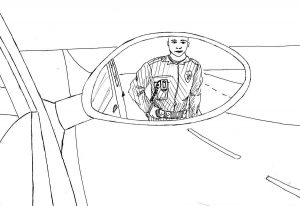On Nov. 24, after three months of deliberating, a grand jury chose not to indict Officer Darren Wilson, who shot and killed Michael Brown, an unarmed teenager. Protests, riots, and looting immediately followed over what many considered to be blatant racism.
However, like many use-of-force cases with police today, the decision was hampered by the lack of video evidence of the incident. While Brown’s attorney said that Brown was trying to surrender when Wilson shot him, Wilson’s attorney stated that Wilson feared for his life and fired out of self-defense.

Considering the discrepancies in the accounts of the case, the presence of body-worn cameras, which are able to capture incredibly clear video and audio evidence of encounters between civilians and officers, could possibly have allowed for a much faster decision that was backed up by indisputable evidence.
At the beginning of this month, in response to Ferguson, President Obama proposed $75 million as part of a broader spending plan to equip police officers with body-worn cameras, but this is not nearly enough funding to finance their implementation in every police department. Citizens must demand that police wear body-cameras and have written policies with public input regarding their specific uses in order to accurately record these encounters and provide unbiased evidence.
In early November, the San Rafael City Council approved the purchase of sixty of these body-worn cameras for its police department. Meanwhile, similar cameras are already used by the Novato, Belvedere, and Tiburon Police Departments.
A study done by The Police Foundation, a nonprofit based in Washington, D.C., reveals the effectiveness of these cameras, testing one group of officers with body-worn cameras and one group without. Results showed that the use of body-worn cameras reduced use-of-force incidents by 59 percent and reduced citizens’ complaints by 87.5 percent.
While most of us do not regularly see use-of-force cases in Marin, especially on the scale of the Brown shooting, ambiguous cases between officers and citizens still do occur in our community, and body-worn cameras have the potential to help provide concrete evidence for these cases in the future.
Last year, police shot and killed 13-year-old Andy Lopez in Santa Rosa, who was carrying a BB gun that the officers claimed resembled an AK-47 assault rifle. Protests ensued, although the sheriff who fired the shots was not charged.
A similar incident occurred in Marin City in July 2013—a sheriff’s deputy shot someone who was attempting to flee after being suspected of driving with a suspended driver’s license. The deputy was not charged.
In both cases, the officers claimed that their lives were at risk, but without proper video evidence, we will never know for certain if this is true or not.
Body-worn cameras, however, cannot be the solution to the larger issues of institutional racism and police brutality. On Wednesday Dec. 3, a NYPD cop was not indicted in the death of Eric Garner, despite video evidence. The footage showed Garner, who was suspected of selling cigarettes illegally, raising both hands in the air and telling the cops not to touch him, the cops putting him in a chokehold and throwing him to the sidewalk, and Garner yelling “I can’t breathe” repeatedly before his death.
Clearly, this case shows that video footage alone will not solve police brutality. However, it does provide indisputable evidence that, even if it didn’t change the verdict, allowed the public to be aware of exactly what happened in the encounter between Garner and the officer.
That being said, in a country of police and government surveillance, some argue that these cameras further invade people’s privacy. Without limits to the use of these cameras, it is understandable that people would be concerned about privacy. A study done by the U.S. Department of Justice and the Police Executive Research Forum showed that of the 63 police departments nationwide that reported that they used body-worn cameras, nearly one third had no written policy on the use of these cameras.
Police accountability must be stricter and more widespread in order to curb the racism and brutality issues that the country still faces today. While body worn cameras will not alone solve these issues, they can provide for more clear court evidence of encounters between police and citizens.
















